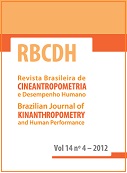Estimation of cardiorespiratory fitness in adolescents with the 9-minute run/walk test.
DOI:
https://doi.org/10.1590/1980-0037.2012v14n4p401Abstract
The aim of this study was to analyze estimation of cardiorespiratory fitness (CRF) in adolescents aged 10 to 12 years by means of the 9-minute run/walk test. A total of 115 adolescents (61 boys and 54 girls) took part in the study. Mean age was 12.2±0.9 and 12.1±0.7 years, body mass 47.5±13.6 and 45.0±13.2 kg, height 150.9±7.7and 150.4±7.3 cm, and VO2peak 49.9±9.5 and 42.2±7.4 mL/kg/min in boys and girls respectively. The subjects performed a maximal treadmill test and a 9-minute run/walk field test (9-minute test). The relationship between VO2 and the 9-minute test was analyzed by Pearson’s correlation coefficient. The difference between the proportions of adolescents who met health criteria and agreement between the CRF cutoff points proposed in the Physical Best and Fitnessgram batteries was analyzed with McNemar’s test and the Kappa statistic respectively. The significance level was set at 5%. There was moderate correlation (r=0.64) between the 9-minute test and directly measured VO2peak in the sample as a whole. Gender-stratified analysis showed higher correlation in boys (r=0.59) than in girls (r=0.43). There were significant differences between the tested cutoff points (P<0.001) and weak agreement (kappa 0.19) in relation to CRF. These findings suggest that the 9-minute test appears to be a valid indicator of CRF in adolescents between the ages of 10 and 12. However, care should be taken when choosing cutoff points for classification of cardiorespiratory fitness.



